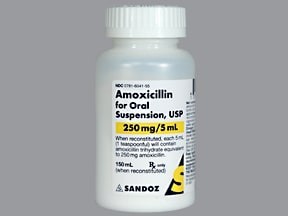A child who weighs 18 pounds receives a prescription for amoxicillin 25 mg/kg/day by mouth in divided doses every 12 hours. The bottle is labelled, "Amoxicillin for Oral Suspension, USP 400 mg per 5 mL." How many mL should the nurse administer with each dose?
(Enter numerical value only. If rounding is required, round to the nearest tenth.)
The Correct Answer is ["1.3"]
1.3 mL of amoxicillin suspension with each dose.
To calculate the correct dose of amoxicillin to give to the child, follow these steps:
Step 1: Convert the child's weight from pounds to kilograms. 18 pounds ÷ 2.2 = 8.18 kilograms
Step 2: Calculate the total daily dose of amoxicillin. 25 mg/kg/day x 8.18 kg = 204.5 mg/day
Step 3: Divide the total daily dose into two equal doses to be given every 12 hours. 204.5 mg/day ÷ 2 doses = 102.25 mg/dose
Step 4: Determine how many mL of the suspension contain 102.25 mg of amoxicillin. 400 mg/5 mL = 80 mg/mL 102.25 mg ÷ 80 mg/mL = 1.28 mL

Nursing Test Bank
Naxlex Comprehensive Predictor Exams
Related Questions
Correct Answer is A
Explanation
At the age of 3, children should be able to speak in simple sentences with a minimum of four words. This is a normal developmental milestone for this age group. Choices B, C, and D are not appropriate developmental milestones for speech and language skills for a 3-year-old child.
Correct Answer is ["1.3"]
Explanation
1.3 mL of amoxicillin suspension with each dose.
To calculate the correct dose of amoxicillin to give to the child, follow these steps:
Step 1: Convert the child's weight from pounds to kilograms. 18 pounds ÷ 2.2 = 8.18 kilograms
Step 2: Calculate the total daily dose of amoxicillin. 25 mg/kg/day x 8.18 kg = 204.5 mg/day
Step 3: Divide the total daily dose into two equal doses to be given every 12 hours. 204.5 mg/day ÷ 2 doses = 102.25 mg/dose
Step 4: Determine how many mL of the suspension contain 102.25 mg of amoxicillin. 400 mg/5 mL = 80 mg/mL 102.25 mg ÷ 80 mg/mL = 1.28 mL

Whether you are a student looking to ace your exams or a practicing nurse seeking to enhance your expertise , our nursing education contents will empower you with the confidence and competence to make a difference in the lives of patients and become a respected leader in the healthcare field.
Visit Naxlex, invest in your future and unlock endless possibilities with our unparalleled nursing education contents today
Report Wrong Answer on the Current Question
Do you disagree with the answer? If yes, what is your expected answer? Explain.
Kindly be descriptive with the issue you are facing.
